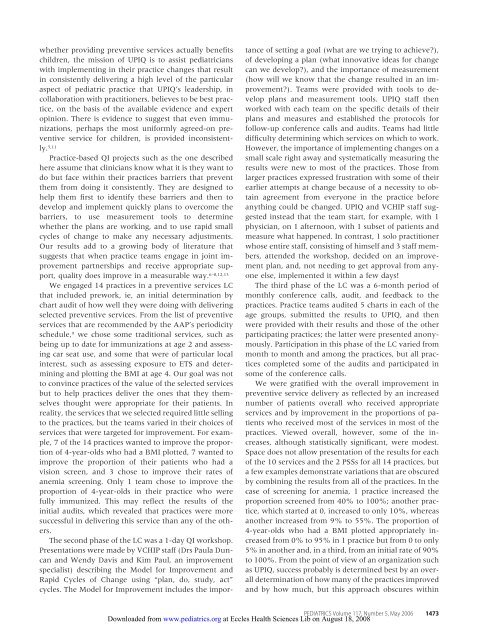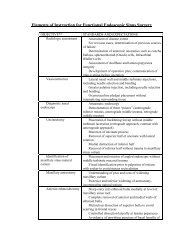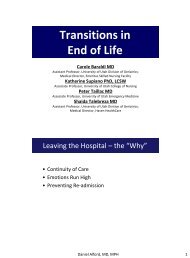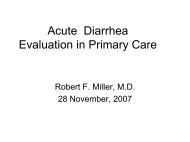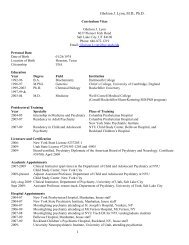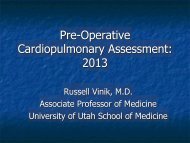Evaluation of a Learning Collaborative to Improve the Delivery of ...
Evaluation of a Learning Collaborative to Improve the Delivery of ...
Evaluation of a Learning Collaborative to Improve the Delivery of ...
Create successful ePaper yourself
Turn your PDF publications into a flip-book with our unique Google optimized e-Paper software.
whe<strong>the</strong>r providing preventive services actually benefits<br />
children, <strong>the</strong> mission <strong>of</strong> UPIQ is <strong>to</strong> assist pediatricians<br />
with implementing in <strong>the</strong>ir practice changes that result<br />
in consistently delivering a high level <strong>of</strong> <strong>the</strong> particular<br />
aspect <strong>of</strong> pediatric practice that UPIQ’s leadership, in<br />
collaboration with practitioners, believes <strong>to</strong> be best practice,<br />
on <strong>the</strong> basis <strong>of</strong> <strong>the</strong> available evidence and expert<br />
opinion. There is evidence <strong>to</strong> suggest that even immunizations,<br />
perhaps <strong>the</strong> most uniformly agreed-on preventive<br />
service for children, is provided inconsistently.<br />
5,11<br />
Practice-based QI projects such as <strong>the</strong> one described<br />
here assume that clinicians know what it is <strong>the</strong>y want <strong>to</strong><br />
do but face within <strong>the</strong>ir practices barriers that prevent<br />
<strong>the</strong>m from doing it consistently. They are designed <strong>to</strong><br />
help <strong>the</strong>m first <strong>to</strong> identify <strong>the</strong>se barriers and <strong>the</strong>n <strong>to</strong><br />
develop and implement quickly plans <strong>to</strong> overcome <strong>the</strong><br />
barriers, <strong>to</strong> use measurement <strong>to</strong>ols <strong>to</strong> determine<br />
whe<strong>the</strong>r <strong>the</strong> plans are working, and <strong>to</strong> use rapid small<br />
cycles <strong>of</strong> change <strong>to</strong> make any necessary adjustments.<br />
Our results add <strong>to</strong> a growing body <strong>of</strong> literature that<br />
suggests that when practice teams engage in joint improvement<br />
partnerships and receive appropriate support,<br />
quality does improve in a measurable way. 6–8,12,13<br />
We engaged 14 practices in a preventive services LC<br />
that included prework, ie, an initial determination by<br />
chart audit <strong>of</strong> how well <strong>the</strong>y were doing with delivering<br />
selected preventive services. From <strong>the</strong> list <strong>of</strong> preventive<br />
services that are recommended by <strong>the</strong> AAP’s periodicity<br />
schedule, 9 we chose some traditional services, such as<br />
being up <strong>to</strong> date for immunizations at age 2 and assessing<br />
car seat use, and some that were <strong>of</strong> particular local<br />
interest, such as assessing exposure <strong>to</strong> ETS and determining<br />
and plotting <strong>the</strong> BMI at age 4. Our goal was not<br />
<strong>to</strong> convince practices <strong>of</strong> <strong>the</strong> value <strong>of</strong> <strong>the</strong> selected services<br />
but <strong>to</strong> help practices deliver <strong>the</strong> ones that <strong>the</strong>y <strong>the</strong>mselves<br />
thought were appropriate for <strong>the</strong>ir patients. In<br />
reality, <strong>the</strong> services that we selected required little selling<br />
<strong>to</strong> <strong>the</strong> practices, but <strong>the</strong> teams varied in <strong>the</strong>ir choices <strong>of</strong><br />
services that were targeted for improvement. For example,<br />
7 <strong>of</strong> <strong>the</strong> 14 practices wanted <strong>to</strong> improve <strong>the</strong> proportion<br />
<strong>of</strong> 4-year-olds who had a BMI plotted, 7 wanted <strong>to</strong><br />
improve <strong>the</strong> proportion <strong>of</strong> <strong>the</strong>ir patients who had a<br />
vision screen, and 3 chose <strong>to</strong> improve <strong>the</strong>ir rates <strong>of</strong><br />
anemia screening. Only 1 team chose <strong>to</strong> improve <strong>the</strong><br />
proportion <strong>of</strong> 4-year-olds in <strong>the</strong>ir practice who were<br />
fully immunized. This may reflect <strong>the</strong> results <strong>of</strong> <strong>the</strong><br />
initial audits, which revealed that practices were more<br />
successful in delivering this service than any <strong>of</strong> <strong>the</strong> o<strong>the</strong>rs.<br />
The second phase <strong>of</strong> <strong>the</strong> LC was a 1-day QI workshop.<br />
Presentations were made by VCHIP staff (Drs Paula Duncan<br />
and Wendy Davis and Kim Paul, an improvement<br />
specialist) describing <strong>the</strong> Model for <strong>Improve</strong>ment and<br />
Rapid Cycles <strong>of</strong> Change using “plan, do, study, act”<br />
cycles. The Model for <strong>Improve</strong>ment includes <strong>the</strong> impor-<br />
tance <strong>of</strong> setting a goal (what are we trying <strong>to</strong> achieve?),<br />
<strong>of</strong> developing a plan (what innovative ideas for change<br />
can we develop?), and <strong>the</strong> importance <strong>of</strong> measurement<br />
(how will we know that <strong>the</strong> change resulted in an improvement?).<br />
Teams were provided with <strong>to</strong>ols <strong>to</strong> develop<br />
plans and measurement <strong>to</strong>ols. UPIQ staff <strong>the</strong>n<br />
worked with each team on <strong>the</strong> specific details <strong>of</strong> <strong>the</strong>ir<br />
plans and measures and established <strong>the</strong> pro<strong>to</strong>cols for<br />
follow-up conference calls and audits. Teams had little<br />
difficulty determining which services on which <strong>to</strong> work.<br />
However, <strong>the</strong> importance <strong>of</strong> implementing changes on a<br />
small scale right away and systematically measuring <strong>the</strong><br />
results were new <strong>to</strong> most <strong>of</strong> <strong>the</strong> practices. Those from<br />
larger practices expressed frustration with some <strong>of</strong> <strong>the</strong>ir<br />
earlier attempts at change because <strong>of</strong> a necessity <strong>to</strong> obtain<br />
agreement from everyone in <strong>the</strong> practice before<br />
anything could be changed. UPIQ and VCHIP staff suggested<br />
instead that <strong>the</strong> team start, for example, with 1<br />
physician, on 1 afternoon, with 1 subset <strong>of</strong> patients and<br />
measure what happened. In contrast, 1 solo practitioner<br />
whose entire staff, consisting <strong>of</strong> himself and 3 staff members,<br />
attended <strong>the</strong> workshop, decided on an improvement<br />
plan, and, not needing <strong>to</strong> get approval from anyone<br />
else, implemented it within a few days!<br />
The third phase <strong>of</strong> <strong>the</strong> LC was a 6-month period <strong>of</strong><br />
monthly conference calls, audit, and feedback <strong>to</strong> <strong>the</strong><br />
practices. Practice teams audited 5 charts in each <strong>of</strong> <strong>the</strong><br />
age groups, submitted <strong>the</strong> results <strong>to</strong> UPIQ, and <strong>the</strong>n<br />
were provided with <strong>the</strong>ir results and those <strong>of</strong> <strong>the</strong> o<strong>the</strong>r<br />
participating practices; <strong>the</strong> latter were presented anonymously.<br />
Participation in this phase <strong>of</strong> <strong>the</strong> LC varied from<br />
month <strong>to</strong> month and among <strong>the</strong> practices, but all practices<br />
completed some <strong>of</strong> <strong>the</strong> audits and participated in<br />
some <strong>of</strong> <strong>the</strong> conference calls.<br />
We were gratified with <strong>the</strong> overall improvement in<br />
preventive service delivery as reflected by an increased<br />
number <strong>of</strong> patients overall who received appropriate<br />
services and by improvement in <strong>the</strong> proportions <strong>of</strong> patients<br />
who received most <strong>of</strong> <strong>the</strong> services in most <strong>of</strong> <strong>the</strong><br />
practices. Viewed overall, however, some <strong>of</strong> <strong>the</strong> increases,<br />
although statistically significant, were modest.<br />
Space does not allow presentation <strong>of</strong> <strong>the</strong> results for each<br />
<strong>of</strong> <strong>the</strong> 10 services and <strong>the</strong> 2 PSSs for all 14 practices, but<br />
a few examples demonstrate variations that are obscured<br />
by combining <strong>the</strong> results from all <strong>of</strong> <strong>the</strong> practices. In <strong>the</strong><br />
case <strong>of</strong> screening for anemia, 1 practice increased <strong>the</strong><br />
proportion screened from 40% <strong>to</strong> 100%; ano<strong>the</strong>r practice,<br />
which started at 0, increased <strong>to</strong> only 10%, whereas<br />
ano<strong>the</strong>r increased from 9% <strong>to</strong> 55%. The proportion <strong>of</strong><br />
4-year-olds who had a BMI plotted appropriately increased<br />
from 0% <strong>to</strong> 95% in 1 practice but from 0 <strong>to</strong> only<br />
5% in ano<strong>the</strong>r and, in a third, from an initial rate <strong>of</strong> 90%<br />
<strong>to</strong> 100%. From <strong>the</strong> point <strong>of</strong> view <strong>of</strong> an organization such<br />
as UPIQ, success probably is determined best by an overall<br />
determination <strong>of</strong> how many <strong>of</strong> <strong>the</strong> practices improved<br />
and by how much, but this approach obscures within<br />
PEDIATRICS Volume 117, Number 5, May 2006 1473<br />
Downloaded from<br />
www.pediatrics.org at Eccles Health Sciences Lib on August 18, 2008


